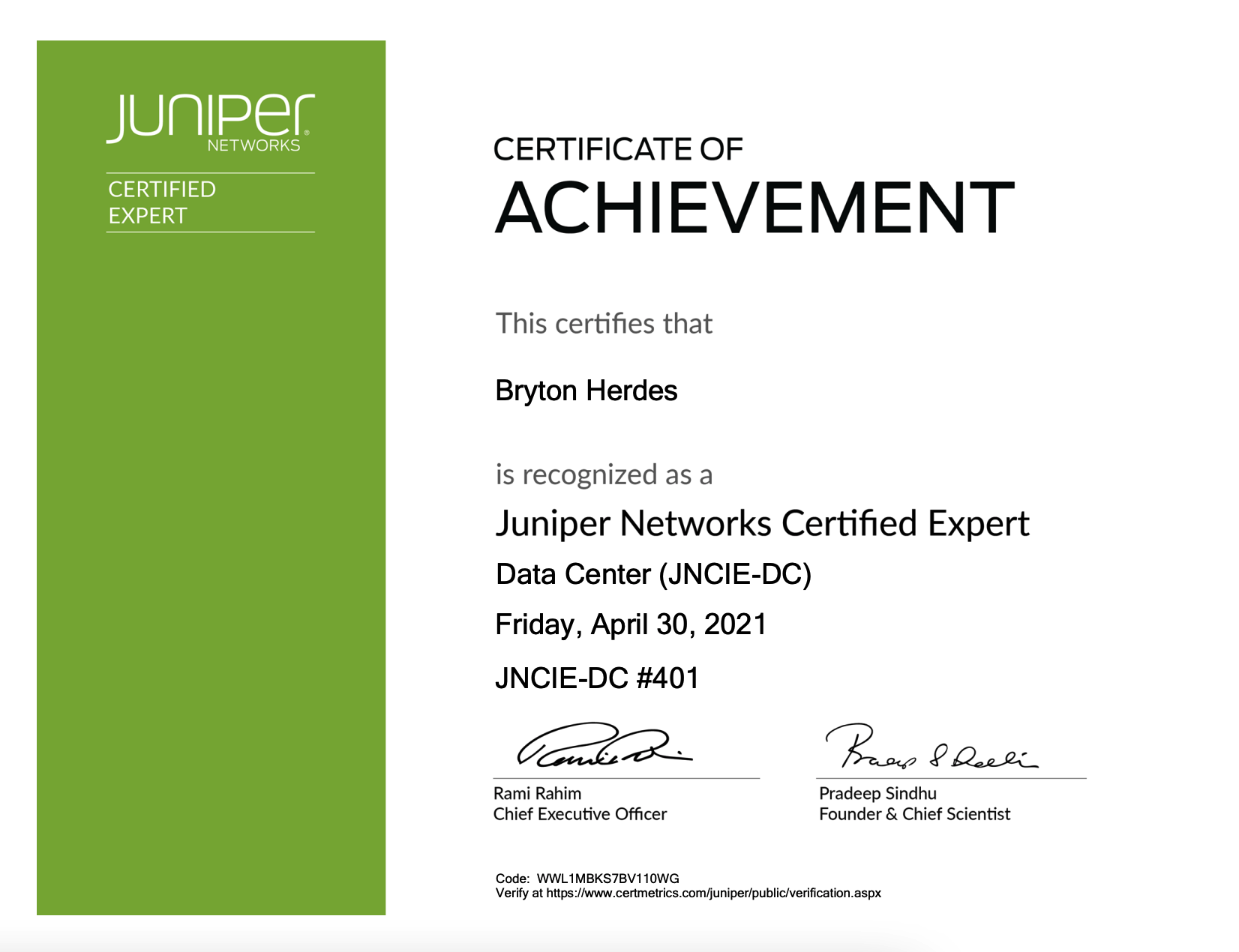JNCIE-DC and Networking Field Day 25
In 2021, I have focused many of my efforts into the JNCIE-DC study journey. After passing my JNCIE-SP in November, I made a goal to bounce straight off of it and segway over to JNCIE-DC. In the world of EVPN/VXLAN, MC-LAG, IP and L2 fabrics, and scripts I was able to carve a path to a passing score, becoming JNCIE-DC #401. Also, you can find me at Networking Field Day 25 as a delegate this week Wednesday through Friday and I’m really looking forward to my first time participating on this panel.
Sweet, Sweet Success
Great you passed, but how did you get there?
My list of Resources
- The official Juniper JNCIE-DC Workbook (purchase directly from Juniper)
- This was by far the most valuable resource. The super labs are great and realistic enough to be useful, and I felt the chapters covered most of what I needed to know.
- Data Center Fundamentals
- 2x QFX5110-48S
- I labbed almost everything for JNCIE-DC in EVE-NG, with the exception of Virtual Chassis Fabric and applying output traffic profiles to interface via CoS. For those things and with limitations within the vQFX, I luckily was able to grab two of these 5110’s from work to practice on.
- RickMur.com
- Rick Mur has really hit a homerun with his efforts in blogging his JNCIE-DC resources and about the remote exam experience in general. He has some amazingly valuable posts that I guarantee will help you in the final leg of your studying.
- jncie.tech
- Within jncie.tech, Alex spent a lot of time documenting his JNCIE-DC study journey as well. He was able to capture some of the “gotchas” that you WILL run into. I’d bet if you run into an issue with something he may have written a piece that will help you.
- Data Center Deployment with EVPN/VXLAN
- Traffic Management User Guide
- Truthfully didn’t use this that much, but for CoS in QFX you may search for a needle in this haystack.
What was your lab practice environment?
Almost all of my labbing was done inside of EVE-NG. If I was labbing MC-LAG, I would get out 3 nodes to act as the 2 ICCP peers and 1 downstream device. I would drill it until I felt I knew all of the nooks and crannies. Then, I would see how it can break and what leaving out specific pieces looks like, what errors JunOS throws in each situation.
Then, I would put that MC-LAG together with a greater topology. Passing the JNCIE of any track is not about just knowing how to configure a technology or protocol, but knowing how to do it and piece everything together to make it work.
Really, my EVE-NG environment was just many vMX’s and vQFX’s and 1 vSRX image. On the server side I had one JunOS Space evaluation image, and a CentOS VM for using with ZTP and scripting. My linux and scripting familiarity is already good so I really didn’t have to hit this stuff all that much.
What’s next?
I’m not sure when I will sit another JNCIE exam, but I’ll probably sit another. I have a lot of at-work projects to focus on for the time being and I’m not sure if I’ll focus on JNCIE study again in 2021. I primarily work with Service Provider protocols and technologies so I was very grateful to get the JNCIE-DC and the knowledge along the way.
Networking Field Day 25
Please come out to Networking Field Day 25 if you’re able to carve out the time or even have the stream as your background work noise. There will be an impressive list of presenters including: kemp, vmware, aruba, ARRCUS, Nokia, ip infusion, Juniper Networks, intel, and path solutions. You’re bound to learn something if you are able to listen in. I’ll be on the delegate panel with many very bright folks, and I’m looking forward to it. I’m confident something will capture my attention and I can report back here to write about it.
AND if you are able to join, hop into the conversation by posing a question or comment on twitter and using hashtag #NFD25

